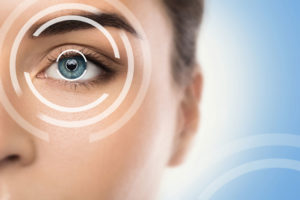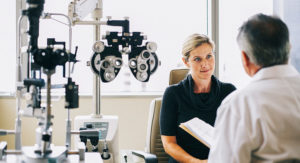
At the very front of your eye, directly in front of your pupil, is your cornea. The cornea allows light to pass into the eye and provides critical focusing power for your vision. Problems such as nearsightedness, farsightedness and astigmatism are often a result of misshapen corneas. For more information about the cornea, continue reading below.
Table of Contents:
- What is the cornea?
- What does the cornea do?
- Parts of the cornea
- Cornea Conditions
- What is a corneal transplant?
At Louisiana Eye & Laser, we can help you ensure clear and healthy vision by offering eye exams and treatments. Just click, call or stop by any of our 14 convenient locations to schedule an appointment.

What is the Cornea?
The cornea is the transparent part of your eye, directly in front of your iris and pupil.
What does the Cornea do?
The cornea is responsible for refracting light that enters the eye in order to focus light rays onto the retina in the back of the eye. Without the cornea, less light would be able to reach the retina and less information about the world around you would be able to be interpreted by the brain. Therefore, the cornea is one of the most important parts of the eye. The importance of the cornea is also reflected by the large number of nerves located within it. These nerves are there to protect your cornea from damage. While most small scratches on the cornea can heal easily without serious damage, deeper scratches can cause scarring that can negatively affect your vision.
Parts of the Cornea
The cornea is made up of five thin layers, each with a specific function. From front to back, these are:
Corneal Epithelium – The corneal epithelium is the surface of the eye, which allows tear film to spread, keeping the eye moist and healthy. Moisture is essential to clear, accurate vision.
Bowman’s Layer – Bowman’s layer is a dense, connective tissue between the corneal epithelium and the stroma. It acts as a protective layer, shielding the stroma from any corneal scratches on the surface. If Bowman’s layer is penetrated, scratches to the stroma may cause permanent scars that impact vision.
Corneal Stroma – The corneal stroma is the thickest, middle layer of the cornea, made up of transparent connective tissue. This layer is what causes the cornea to be transparent.
Descemet’s Membrane – The corneal stroma is separated from the corneal endothelium by Descemet’s membrane. This extremely thin layer of the cornea gradually thickens throughout life.
Corneal Endothelium – The corneal endothelium maintains fluid content within the cornea. If damaged, swelling may result, causing damage to the cornea and vision overall.

Cornea Conditions
There are a number of conditions that may affect the cornea either directly or indirectly. Among the more common problems patients encounter are:
Arcus Senilis (Corneal Arcus) – Arcus senilis is a condition affecting older individuals. This is when a white ring forms in the periphery (side) of the cornea. While corneal arcus is typically related to aging, it may also be caused by high concentrations of fats or lipids in the blood.
Corneal Abrasion (Scratched Cornea) – Depending on the severity, corneal abrasions can be painful. Patients with a scratched cornea may also be at an increased risk of an eye infection.
Corneal Dystrophy – Corneal dystrophy is a condition in which part of the cornea loses its clarity due to a buildup of cloudy material. The most common type of corneal dystrophy causes cloudy morning vision and is known as “Fuch’s dystrophy.” Fuch’s dystrophy affects the corneal endothelium and may cause swelling and light sensitivity.
Corneal Ulcer – A corneal ulcer is an inflammation or infection of the cornea. A corneal ulcer may cause pain, scarring and loss of vision. It affects the corneal epithelium and the corneal stroma.
Dry Eye – Dry eye is a condition in which the eye does not produce enough quality tears. Although dry eye is not caused by a problem with the cornea, it may cause problems for the cornea. Dry eye can damage the corneal epithelium, causing discomfort and potentially damaging vision.
Keratitis – Keratitis is an inflammation of the cornea, which can be very painful.
Keratoconus – Keratoconus is a degenerative disease in which the cornea becomes thinner and more cone-shaped. Keratoconus causes vision problems that can not be corrected by standard eyeglasses or contact lenses.
What is a cornea transplant?
A cornea transplant is a surgical procedure in which a person’s damaged cornea is replaced with a new, undamaged, cornea. The undamaged cornea is acquired from a donor who has recently passed away. The procedure that is performed to replace the damaged cornea is known as Keratoplasty. Depending on the situation, different types of Keratoplasty procedures may be required. There are a number of reasons why a person may require a cornea transplant. Eye infections, corneal abrasions and even thinning of the cornea are possible reasons that a patient may need a cornea transplant.

Cornea Care at Louisiana Eye & Laser
Every eye exam at Louisiana Eye & Laser involves an examination of the cornea. Whether you are experiencing symptoms or if you’re simply due for a routine exam, the experts at Louisiana Eye & Laser are here to help! Call, go online, or stop by one of our offices to schedule an eye exam today. At Louisiana Eye & Laser, we’re here to help you live life to the fullest with the clear, healthy vision you deserve.




